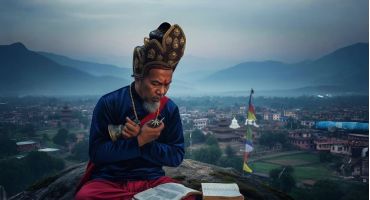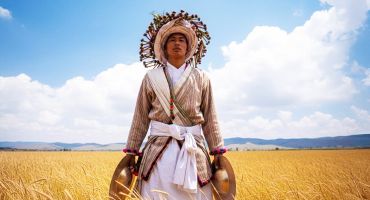Newari culture would be a tad bit different, were it not for the masked dances. The complexity, richness, and multi-layered aspects of Newari culture are revealed not only through its bright festivals or its exuberant art, but also from its grand masked dances called “Pyakha”. In the Newari/Newa language, the term “Pyakha” could denote either a Drama or Dance. Masks form the obligatory central portion during any Pyakha performance. The mask, which covers the face of the performer is called the Khwapa, which, interestingly, in the Newari language, is also the word for “face”. In the old days, Masks were usually made by members of the local Chitrakar, painter caste. Although in many areas of Lalitpur, the Sakya Newars used to make and paint their own masks and in Bhaktapur, the “Jyapu” Newars of the Potter class made the Masks.
If we look at the majority of masks in Newari traditions, we discover a complexity of structure with vivid, garish, multi-colored designs that often appear decorative. Most masks are made up of clay mixed with paper-mache and Jute. Clay molds are used to shape them. Masks that portray the various characters and their temperaments are given their shapes accordingly. The masks are then varnished and colored with great precision and care. There has also been a tradition of making metal Masks in Patan, a place that is still renowned for its metalwork. We can ascertain that the greater number of Himalayan cultural masks are but of simple construction. Yet, its design, details, and the expressiveness of these elements only reflect or correspond to the straightforward and fundamental religious concept of animism.
Newari masks provide a tangible form for invisible spirits and deities, who are personified as human beings, animals, or fantastic composites of the masculine and the feminine. There will be Ganesh, Varaha, and their Vahanas. The entire Pyakha performance will have animal characters, demons, and spirits. There will also be human characters or men and women, priests and merchants. These theatricalities form the major attraction of any festival that happens in the Kathmandu valley and while the stories are often based on mythology and folklore, some of the Pyakha performances can also be comical. The fool, jester, or clowns have their own masks, which are worn during a comic performance. The masks that these comedians wear are half masks that are known as “Ba Khawapah” where the mouth is left uncovered because the performance could involve a dialogue between the characters or a soliloquy could ensue.
During a performance, masked dancers imitate the actions of deities. Their behaviors are supposed to serve as models for positive human behavior. However, much of the performance isn’t altogether based on upholding morality in society. Instead, Pyakha is more about upholding traditions. From the creation of the masks to the preparation and the ultimate performance, the entire extravaganza is built up of traditions that have last for many centuries. Even the color of a particular mask doesn’t seem to have changed over the many years that Pyakha and the Khwapa have both existed. While the color of the masks differ according to a character or a deity that it’s supposed to embody, Black is used to depicting demons while blood-red would denote anger, greed, or even power. Green is associated with nobility and blue to depict the Gods of the Hindu pantheon.

While the origin of the masked dances in Newari culture may have been to propagate religious precepts, that is not the only thing that happens during these performances. Masked dances narrate dramas, which are derived from conventional Hindu literature, with plots and characters that people are familiar with. Newar masked dances are also based on local folklore and traditions that are conventionally local in nature and idea. There is a considerable amount of comedy that provides some sort of relief to the onlookers amidst heavy action and dancing.
It is likely that Newari artisans in the medieval ages were inspired to create masks that would appear mysterious yet magnanimous, frightening but captivating. This is exemplified by the famous Lakhey Mask. Lakhey is one of few dancers who take turns donning the 15-kilogram headgear complete with red mask and hair. The Lakhey ritual is tied to the annual chariot ride of the Kumari, the living goddess of Nepal, which is the highlight of the Indra Jatra festival. Because of his fearful demeanor and captivating aggressive dancing, Lakhey is perhaps the most famous one among all masked dances.

These Newar masks are distinct from either Tibetan or Indian. Their details in the shapes, the materials used, the specificity of the paintings, and decorations are all absolutely different from anything ever seen in other parts of the Himalayas. Both the Pyakha and Khwapa are quintessential living traditions that have been transmitted orally from generation to generation. These are a few of the hallmarks of rich Newari culture and traditions.






Leave a Reply